A plant such as begonia (Begonia) belongs to the most famous and numerous genus of the begonia family. This genus unites about 1,000 species of a variety of plants that can be found in natural conditions in the mountains, and they prefer to grow at an altitude of 3-4 thousand meters above sea level, they are also common in tropical rainforests and subtropics. And these plants are also found in the mountains of India, in the Malay Archipelago, in the Himalayas, in Sri Lanka and in western Africa. There is an opinion that begonia comes from Africa, and then this plant came to America and Asia. Today, more than 1/3 of all species of this plant grow in Africa.
In the 17th century, the monk Charles Plumier found begonia and described it. This happened during an expedition to the Antilles, the purpose of which was to collect plants. He discovered 6 different species of such a plant, which he named in honor of M. Begon, who was the governor of Fr. Haiti, with whom the monk was friends. Today this plant is very popular and is cultivated both indoors and in the garden. Below we will talk about room begonia and how to plant it correctly, how to care for it, how it can be propagated, and a lot of other interesting and useful information.
Content
Features of begonia
In addition to about 1,000 species existing in nature, there are still about 2,000 hybrids of this plant. In this regard, an average description of this plant simply does not exist. Plus, such plants in various classifications are divided into decorative flowering and decorative deciduous, deciduous and evergreen, perennials and annuals, creeping and tall, rhizome and tuberous. Florists grow a huge variety of begonias at home, and all of them need to be looked after at home in about the same way.
Home begonia care
How to care for begonia
Home-grown begonia needs consistency. In this regard, she needs to choose 1 specific place in the room where the flower will stand all the time. The area should be well lit, but the plant should not be exposed to direct sunlight. Decorative-flowering species are especially light-requiring, in this regard, it is recommended to choose a window sill of western or eastern orientation for their placement. The plant feels best at an air temperature of 18 degrees at any time of the year. However, in the summer, it is able to withstand a slight increase in temperature.
Since this plant is tropical, it needs high humidity. However, it is not recommended to moisten the foliage of the flower from a spray bottle, because after this procedure specks of brown color are formed on its surface. In order to increase the humidity of the air (especially in the winter period, when the air is dried by heating devices), you need to turn the pallet over and insert it into a larger pallet, then a container with a flower is installed on top of it. Expanded clay should be poured around the inserted pallet and wetted, while ensuring that it is constantly moistened.
Begonia needs space, in this regard, when choosing a place for it on the windowsill, where other plants already stand, this fact must be taken into account. Also, this flower needs systematic ventilation, while it must be protected from drafts and excessively high or low air temperatures. If these conditions are not met, the flower will begin to wither, and will also drop leaf plates and flowers.
Soil and pot selection
Before proceeding with the direct planting of begonias, you must choose the most suitable pot for it. For such a plant, it is recommended to choose a small pot, which must be made of ceramic. So, the diameter of the container should exceed the size of the root system of the flower by only 3-4 centimeters. If it is planted in a larger pot, then the plant may suffer from waterlogging of the soil, and also in this case it will bloom a little later. You can buy ready-made soil mixture for planting at a special store, but if you wish, you can prepare it with your own hands. To do this, combine leafy soil, sand, high peat, turf soil (can be replaced with humus), taken in a ratio of 2: 1: 1: 1. The acidity of the soil should be approximately pH 5.5 to 6.5.
Planting begonias
The container for planting begonias is 1/3 filled with drainage material. Then a two to three centimeter layer of charcoal must be laid on it, which is necessary to prevent the development of rot. After that, the flower itself must be placed in the container along with a lump of earth and it remains only to fill all the available voids with earth mixture. When the plant is planted, it needs to be watered. It is recommended to plant begonias in spring from the second half of March, after the light level and the duration of daylight hours become suitable for its growth. If the plant is tuberous, then it needs preliminary germination. To do this, the tubers are placed on top of the substrate in a box (not buried), and removed to a normally lit, cool (from 16 to 18 degrees) place with a humidity level of 60 to 70 percent.
How to water properly
If begonia is grown indoors, then it just needs to be watered correctly. Such a plant loves moisture, but it does not need frequent watering. It is much more important that the air humidity is high enough, otherwise the tips of the leaf plates will begin to dry out. However, in summer, in the heat, begonias should be watered more abundantly, but at the same time, stagnation of liquid in the root system should be avoided. Water it with water at room temperature, which should be defended for at least 24 hours.Watering is recommended only after the topsoil dries out to one and a half centimeter depth. In winter, plants should be watered less frequently and in moderation, but if you have tuberous species, then at this time of year they should not be watered at all.
Top dressing
In order for begonia to grow and develop normally, it must be fed in a timely manner. It is necessary to start feeding decorative flowering species after the budding period begins. Top dressing is carried out 1 time in 2 weeks and use for this liquid complex fertilizer for flowering plants. When the formation of the ovaries begins, the plant will need to be fed with potash-phosphorus fertilizers (Ovary, Bud, Pollen). Fertilizers containing nitrogen, it is necessary to feed only decorative leafy species, otherwise the flowering of decorative flowering species may not start at all.
How to transplant
In order for the plant to develop normally, it must be systematically transplanted. The transplant is carried out at the beginning of the spring, before the growing season begins. The fact that the plant needs a transplant is indicated by its roots, which begin to appear from the drainage holes. The plant should be pulled out of the container and the remaining substrate should be carefully removed from it. Then the roots should be dipped in a solution of potassium manganese, the color of which should be light pink. After that, the roots must be carefully washed, removing the remaining soil, using well-settled water for this. Then an inspection of the root system is carried out and those areas on which there is rot are removed. After the root system dries up, the plant must be planted in a larger container. How to do it correctly is described above. After transplanting, the begonia must be put in its usual place. At first, she will need frequent watering.
It is quite simple to transplant young specimens, and they respond normally to this procedure. However, adult specimens are somewhat more difficult to transplant, because they have many overgrown fragile leaf plates. In this regard, after the flower turns 3 years old, it is recommended to divide it into several parts.
Begonia in winter
Evergreen species have a mild dormant period. Tuberous species need a fairly long rest period. The peculiarities of begonia care in winter, when a dormant period is observed, directly depends on the species. Shrub, as well as decorative species at this time are placed in a place where the air temperature should be from 15 to 22 degrees and there is high humidity (for this, you can hang moistened rags on hot heating pipes or purchase a humidifier).
From the middle of the autumn period, the tuberous species of this plant begins to prepare for the dormant period. Their leaf plates dry up and die off, in this regard, such flowers need less watering. After the complete withering away of the aboveground part of the container with plants, it is necessary to rearrange the darkened cool (from 10 to 15 degrees) place for the whole winter. It happens that tuberous plants "do not want" to prepare for a dormant period, in this case they must be forced to do so, otherwise you will not see a lush flowering next year. So, watering should be significantly reduced, and the part of the plant that is above the soil surface should be cut off.
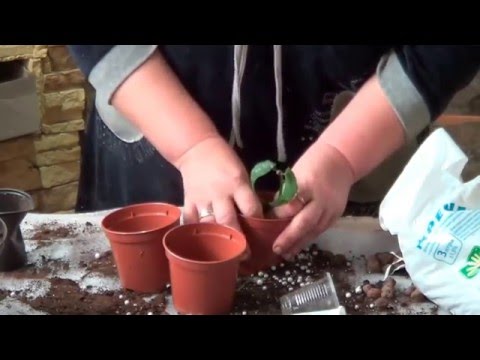

Watch this video on YouTube
Breeding methods for indoor begonia
How to propagate
Such a plant can be propagated by seed or vegetative (stems, leafy cuttings, dividing a bush or tuber or rhizome) in a way. The easiest and fastest way is vegetative.
Growing begonias from seeds
It is quite easy and quick to grow begonia from seeds. Sowing is carried out in the last days of February or the first of March. To do this, small seeds must be spread over the surface of the substrate (do not cover).Then the container should be moved to a well-lit, warm place, having previously covered it with film or glass. Crops should be watered through a pallet or with a spray. After the first seedlings appear, the shelter should be removed for good. The pick is made after the plants have 3 or 4 true leaf plates. After 8 weeks, young plants can be transplanted into individual pots. Such begonias may begin to bloom in the first year, but in order for this to happen, they often need additional lighting.
Tuber (rhizome) division
For propagation of deciduous species, rhizome division is used. This procedure is carried out in the spring. To do this, you need to pull the flower out of the soil and divide the rhizome into several parts with a very sharp knife, while each division must have roots and at least 1 shoot or bud. Places of cuts should be sprinkled with crushed charcoal. After that, the delenki are planted in individual containers.
The tuber of an adult plant can also be divided into several parts. After that, you need to wait until the cuts are slightly dry and dust them with chopped charcoal. Then the cuttings are planted in individual containers.
Propagation of begonias by cuttings
The simplest of all vegetative propagation methods is cuttings. Cuttings with 3 or 4 leaf plates must be cut from the bush. To prevent rot on the cuts, they should be treated with charcoal. Then the cutting should be planted in a mixture of leaf and peat soil and sand (1: 1: 1). The container is placed in a well-lit, warm place, in which there is no direct sunlight. The cuttings need moderate watering, so it is necessary to moisten the soil only after the soil dries out to a depth of 1 to 2 centimeters. You can root the cuttings by immersing them in a glass of water. The roots will grow back after about 4 weeks.
Begonia leaf propagation
Since most species have fairly large and dense leaf plates, they can be propagated by leaf cuttings. At the same time, both the entire leaf plate and its part are suitable for reproduction. If begonias are propagated with a whole leaf, then the main veins must be incised on its seamy side. Then the sheet plate is laid with the cut side on the surface of the moistened sand, which must be calcined in advance. After that, it is fixed in this position. Watering is carried out through the pallet. After about 8 weeks, roots will appear from those places that are incised, and after a while young plants will begin to grow. The grown, grown young begonias should be separated and planted in a soil mixture consisting of deciduous soil, sand and peat (1: 1: 1).
Diseases and pests
Aphids, red spider mites and nematodes can settle on indoor begonias. Ticks and aphids suck sap out of the plant, as a result of which it loses its decorative effect and slows down its growth and development. To combat aphids, Karbofos or Actellic is used, while 2 or 3 treatments are needed with an interval of 1-1.5 weeks. And to combat ticks, a tool such as Derris, Decis or other insectoacaricides is used. If infected with nematodes, the plant will have to be thrown out, since you cannot get rid of them. You can find out that begonia is infected with nematodes by discolored leaf platinum and by influxes on the root system.
Begonia is susceptible to diseases such as: gray rot, black root rot, botrytis, powdery mildew or downy mildew. Fundazol, Quadris, Bordeaux liquid, Skor or other means of similar action will help to cure the plant. Also, this plant is susceptible to infection and incurable viral or bacterial diseases, for example: bacterial wilting, cucumber mosaic, tomato spot. The infected instance must be destroyed.
Begonia dries
Sometimes it happens that the leaf plates begin to dry out.The reason for this is that the air in the room is too warm and dry, as well as excessively poor watering. In this case, the begonias should be watered and placed in a cool place, while the pot should be placed on an inverted tray (see above for more details).
Begonia turns yellow
It happens that rings or spots of yellow color form on the surface of the leaf plates - this is a sign of infection of the plant with tomato spot or cucumber mosaic. Infected specimens should be destroyed. If the leaves turn yellow and droop, then the reason for this is that the plant is too cold, and the soil contains too much water. Wait for the potted medium to dry well and then move the flower to a warm place.
The main types and varieties of begonias with photos
There is no single classification of begonias at the moment. However, in the specialized literature one can come across conditional variants of the division of the species of a given plant, for example: into decorative flowering and decorative deciduous; they are also divided according to the type of the part of the plant located underground, into tuberous, rhizome and with a surface root system; there are those who divide these species into the following groups - bushy, decorative deciduous and tuberous. However, today experts are increasingly resorting to the following classification:
- bushy with erect babmbuk-like stems;
- with flexible and thin drooping or creeping stems;
- with sufficiently thick rhizome, lying or lodging stems;
- species that are the ancestors of flowering hybrid begonias.
However, for home floriculture, such a classification is more convenient:
- decorative flowering indoor plants;
- decorative deciduous indoor plants;
- decorative flowering potted plants.
Below will be presented the names of the species of such a plant, which are most popular in home floriculture, with their descriptions, as well as with common varieties.
Leafy (deciduous) begonia
Royal begonia (Begonia rex)
The homeland of such a flower is East India. It is considered one of the most beautiful. Breeders have used this species to create many decorative leafy varieties, as well as hybrid forms. The plant has a rhizome, which is thickened, and its spectacular large leaf plates are bare or with a slight pubescence reach 20 centimeters in width and 30 centimeters in length. Their heart-shaped shape is asymmetrical, their edge is unevenly serrated or wavy. The color of the leaves can be brown-bronze, crimson-velvety or violet-red, sometimes specks of silver or purple-red color can be seen on their surface. There are hybrid forms, the leaf plates of which are almost black, and crimson specks are located on their surface. During flowering, pink flowers appear, which are not of particular decorative value.
Popular varieties:
- Cartagena - oval leaf plates, which are wrapped in a shell, are colored dark green. The central part of the leaf is dark brown, but with age it changes its color to plum. On the green part of the leaf plate there are spots of a silvery color with a light pink glow.
- Silver Greenhart - leaf plates of a silver color have an oblique heart-shaped shape, they also have a green-emerald border with small dots of a silver color.
- Chocolite Cream - the leaf plate is spiral-twisted and its central part is painted in a deep plum color. The rest of the leaf has a silvery color with a pinkish tint.
- Evening Glow - the leaf plates are of medium size, and their central part is painted in a deep crimson color. From the center, along a part of a crimson leaf, veins of a brownish-green color diverge. The leaves have a crimson edge.
- Hallelujah - has large leaves that are spirally twisted at the petioles. They are colored light purple with a silvery sheen. The central part and the edge of the cherry-colored leaves, while between them there is a fairly wide strip of saturated green color, on the surface of which there is a huge number of silvery small spots.
In addition to the varieties mentioned above, growers also grow others. For example, the following varieties and hybrid forms are very popular: Pearl de Paris, Regal Minuet, Silver Corcscrew, Black Fang, November Frost, Lilian, Red Tengo, Titica, Benitochiba, Dewdrop, Sharm, etc.
Tiger begonia (Begonia bowerae), or Bauer's begonia, or maple-leaved begonia
The homeland of this plant is Mexico. The bush is low (no more than 25 centimeters), has creeping shoots and leaf plates of a pale green color, on the edge of which there are specks of brown or black. On the seamy side of the leaves is pubescence. Unremarkable pale pink flowers are part of loose drooping inflorescences. This species is rarely seen in the wild. Thanks to specialists, a large number of very beautiful varieties were born.
The most popular are:
- Tiger - creeping shoots can be no more than 10 centimeters high. There is a bronze pattern on the surface of the velvety leaves, a strip of brown color runs along the veins. There are specks on the surface of light red petioles.
- Cleopatra - on the surface of these leaf plates there are hairs of a light color, and they are able to change their color when changing lighting. The seamy side of the burgundy or red leaves.
Coral begonia (Begonia corallina)
Such begonia is semi-shrub, and its homeland is the tropical forests of Brazil. At home, the plant can grow up to 100 centimeters in height. Possesses bamboo, erect and naked shoots. Oblong ovoid leaf plates have a serrated edge. They can be 20 centimeters long and 7 centimeters wide. On the surface of the dark green front side of the leaves, there are small spots of a silvery color, while the back side is pale green in color. Peduncles are coral in color. They bear flowers, which are part of the inflorescences in the form of a brush. Popular varieties:
- Alfalfa - large green leaf plates have a jagged edge, there are silver spots on their front side, and a red color on the wrong side.
- President Carnot - the thyroid sheet plates at the base are dissected, and their edge is weakly serrated. The leaves are 30 centimeters long and 15 centimeters wide. They are colored green and have whitish specks on the surface.
Begonia carolineifolia
This begonia is one of the oldest home flowers. Her homeland is Mexico. The creeping shoot is about 4 centimeters thick. Large, finger-dissected leaf plates are placed on greenish-yellow petioles. The leaves do not exceed 35 centimeters in length, there is a well-visible venation. Pinkish-green flowers are part of loose, brush-shaped inflorescences. Flowering begins in February.
In addition to these species, florists are popular: striped, metal, Bover, yellow, shiny, Mason, hogweed, white-point, red-leaved, Limming, imperial, etc.
Decorative flowering begonia
Ever-flowering begonia (Begonia semperflorens)
The height of a compact bushy bush does not exceed 60 centimeters. In a young plant, the stems are erect, but over time they take an ampelous or semi-ampelous form. Rounded leaf plates have a slight pubescence along the edge, and they reach 6 centimeters in length. They can be painted in dark or pale green color, and also with a reddish tint.Small (about 25 mm in diameter) flowers, double or simple, can be painted pink, white or red. They are part of inflorescences that are short-lived. The opened flowers do not please with their beauty for long and soon fade, but they are very quickly replaced by new ones. With proper care, good lighting and regular feeding, such begonia can bloom in the winter. Popular varieties:
- Gustav in Knaak - the height of the spreading bush can reach about 30 centimeters. Green leaf plates have a red border. The diameter of carmine flowers is about 3 centimeters, and they are part of the inflorescences.
- Carmen - on a medium-sized bush there are brown leaf plates with anthocyanin. There are also many pink flowers.
- Ambergris - the height of the bush does not exceed 15 centimeters, the leaf plates are brown, and the diameter of pink flowers is not more than 3 centimeters.
- Bicol - the height of the bush reaches 14 centimeters. The leaves are green, and the white flowers have a light pink border.
- Orania - a small bush, whose height is about 16 centimeters. Green leaf plates have a red border. The flowers are reddish orange.
And flower growers prefer to grow such varieties of this type as: Bella, Rozanova, Linda, Othello, Teikher, Leila, Lucifer, Scarletta, Albert Martin, Ball Red, Kate Teikher, etc.
Begonia elatior (Begonia x elatior)
This hybrid form is considered the most spectacular and has the most abundant flowering. Among domestic begonias, such a plant is a favorite. The height of the bush does not exceed 40 centimeters. Shoots are thick, fleshy, the shape of the alternate leaf plates are cordate. The length of the leaves is about 8 centimeters, while their edge is indented. The front side of the leaves is shiny, saturated green color, and the back side is matte and painted in light green. Flowers are part of inflorescences and have long peduncles. Popular varieties:
- Schwabenland - on a tall, profusely flowering bush there are many small rich red flowers.
- Renaissance - on a tall bush there are double flowers, red petals of which are corrugated.
- Louise - flowers are painted in a pale cream color, have a light pink tint.
- Piccor - on a low bush there are deep pink flowers, which are double.
- the Rose - double flowers have a dark pink color.
Also popular among flower growers are such varieties as: Kyoto, Goldfinger, Azotus, Berlin, Sharlach, Cleo, Annebel, Bellona, etc.
Ampelous begonia (Begonia x tuberhybrida pendula)
Often this species is grown as a garden flower or is used to decorate balconies and terraces. Such a flower has drooping stems that descend in cascades, and a large number of flowers are located on them. To grow such plants, baskets, pots or pots are used. Flowers can be double, double, semi-double, as well as simple, and they are painted in red, yellow, white, pink, orange, as well as in various combinations of these color shades. Flowers can be large, medium and small. Popular varieties:
- Gail - on a sprawling bush there are hanging long (about 30 centimeters) stems, in the upper part of which there are pointed green leaf plates with a jagged edge. Light pink semi-double flowers in diameter can reach 3 centimeters.
- Christie - a sprawling bush consists of rather fragile hanging stems, which do not exceed 40 centimeters in length. The diameter of the double flowers is 4 centimeters, and they are painted white.
- Roxanne - a small bush consists of hanging stems, the length of which does not exceed 40 centimeters. Double flowers of four centimeters in diameter are colored orange.
- Kati - a sprawling bush consists of relatively fragile stems, the length of which is about 30 centimeters. The diameter of the semi-double yellow flowers is 3.5 centimeters.
The most popular hybrid varieties of decorative flowering begonias
- Harlequin - the height of the spreading bush is up to 25 centimeters, the leaf plates are green, and the large (12 centimeters in diameter) double flowers are yellow and have red edges.
- Gold Dress - the height of a semi-spreading bush is about 25 centimeters. The leaf plates are pale green. Densely double pink flowers are rather large (diameter 20 centimeters) and are yellow.
- Duck Red - the sprawling bush reaches a height of no more than 16 centimeters. The leaves are deep green, and the peony double flowers are dark red. The diameter of the flowers is about 10 centimeters, while the petals are quite wide.
- Camellia Flora - a small bush is about 25 centimeters high. The leaf plates are green. Large (diameter about 12 centimeters) camellia flowers are painted pink, and their petals, which have whitish edges, are tiled.
- Crispa Marginata - the height of the bush is about 15 centimeters. The folded sheet plates are green and have thin purple ropes. Large (about 12 centimeters in diameter) wide-oval flowers are white and have a deep red border. The side lobes are wavy and strongly corrugated.
- Amy Jean Bard - the height of the bush is no more than 12 centimeters. Green leaf plates are small. The inflorescence includes 5 small (about 3 centimeters in diameter) double flowers with an orange color.
- Dayana Vinyard - the height of a small bush is about 20 centimeters. The leaves are pale green. Large (diameter about 20 centimeters) densely double flowers are white in color, as well as wavy folded petals.
- Marmorata - the height of a semi-spreading bush is about 20 centimeters. Terry large (about 12 centimeters in diameter) flowers are painted in a scarlet color, and there are whitish streaks on their surface.
- Feyerflamme - the height of the bush does not exceed 20 centimeters. The leaf plates are green and the veins are crimson. Small (about 3 centimeters in diameter) semi-double flowers have a pinkish-orange color.

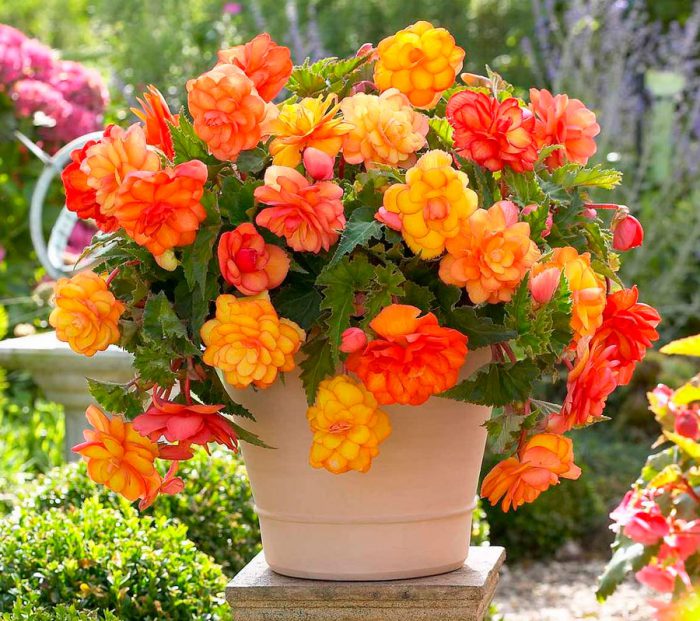
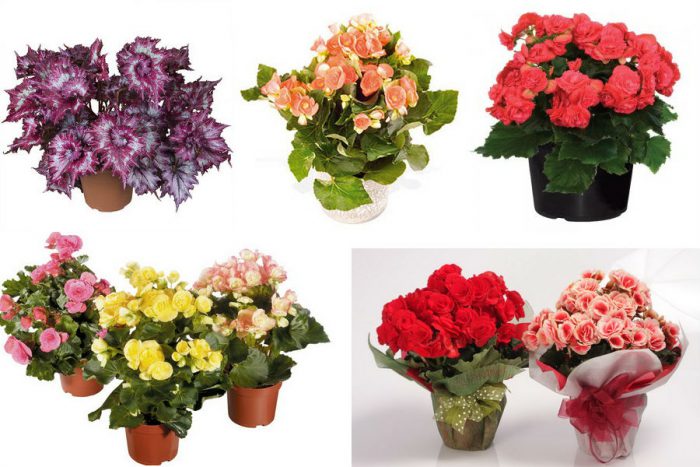
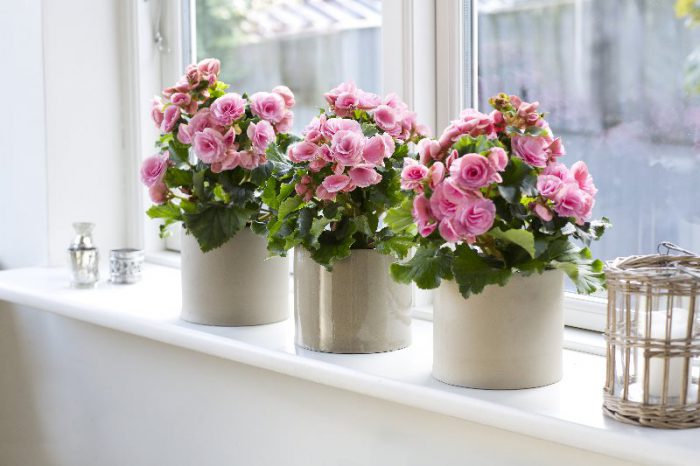
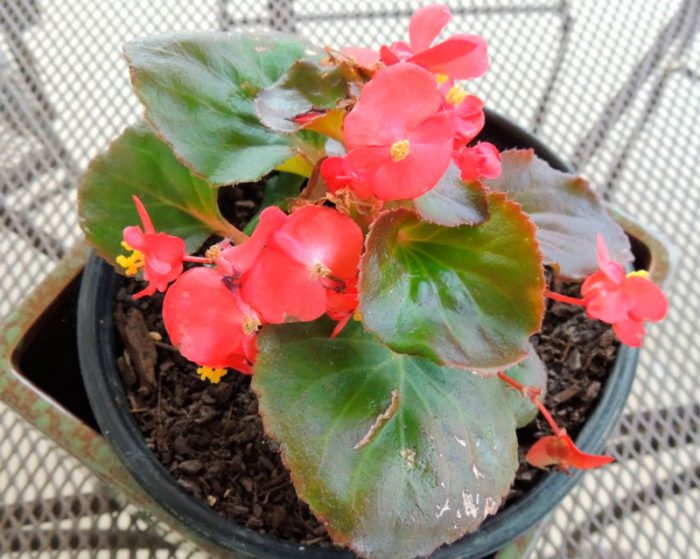

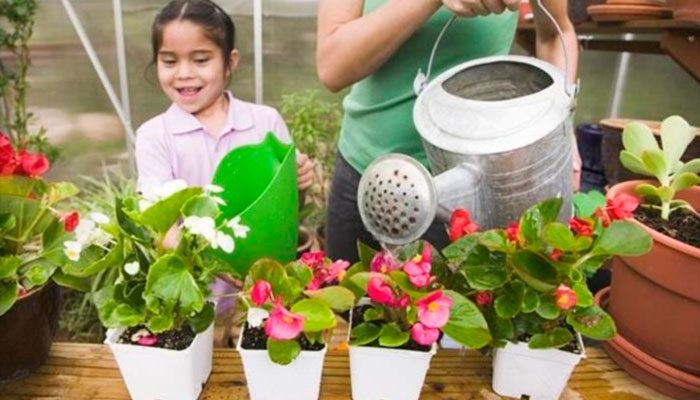

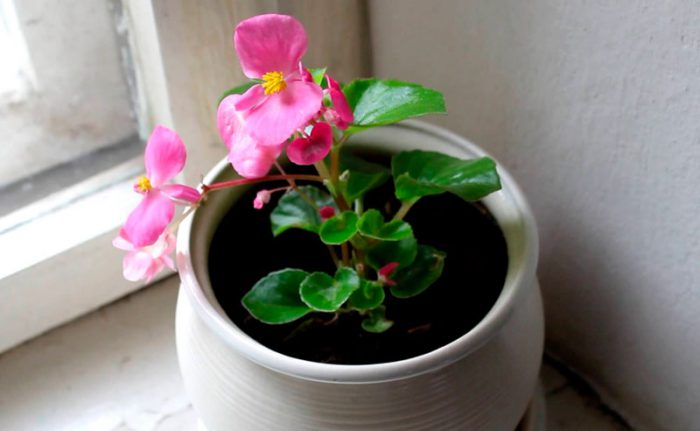
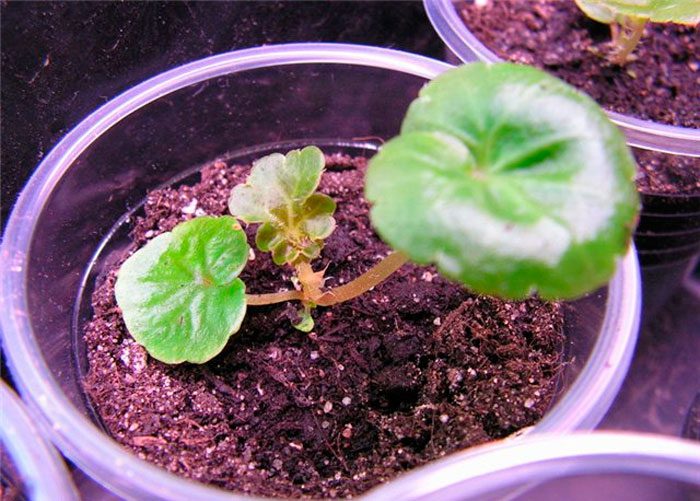



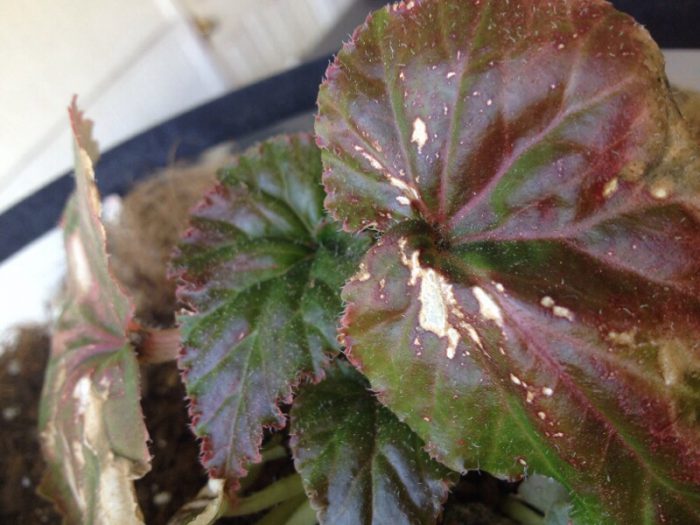

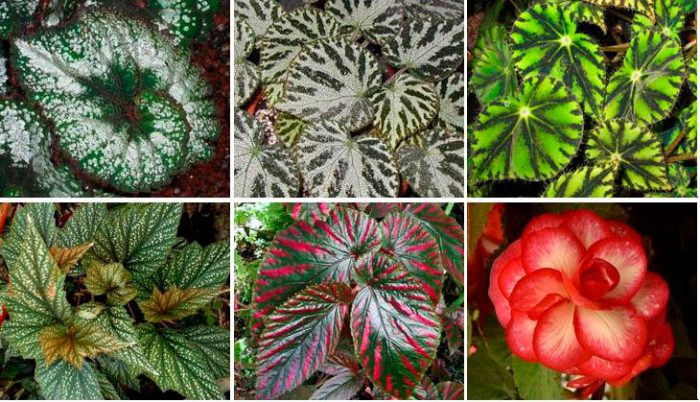
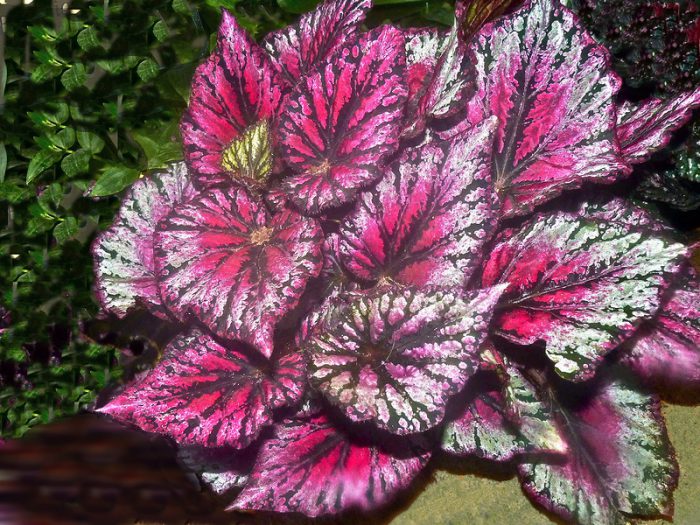


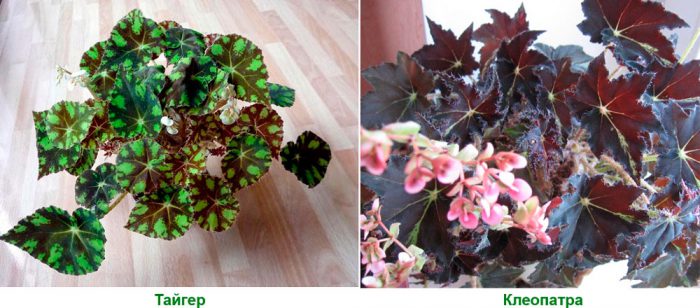
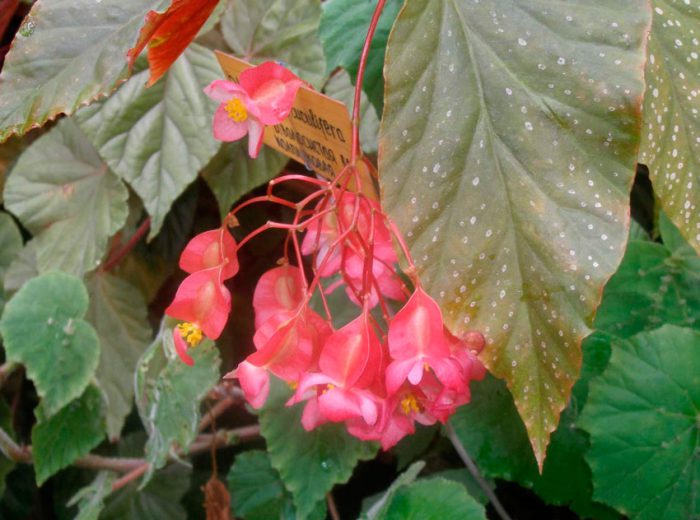
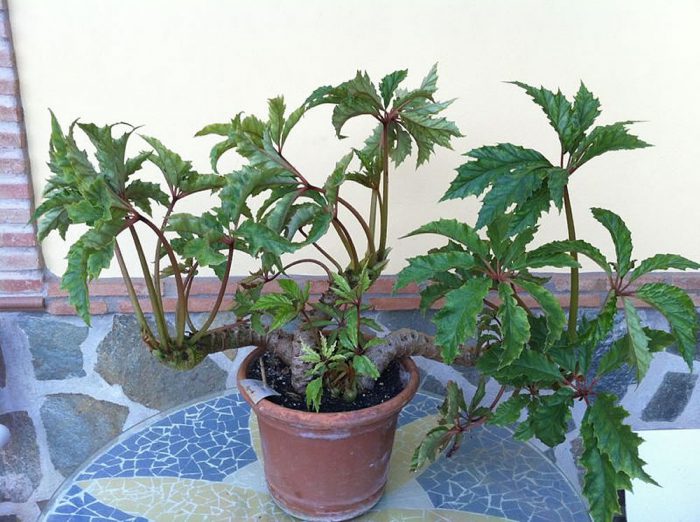
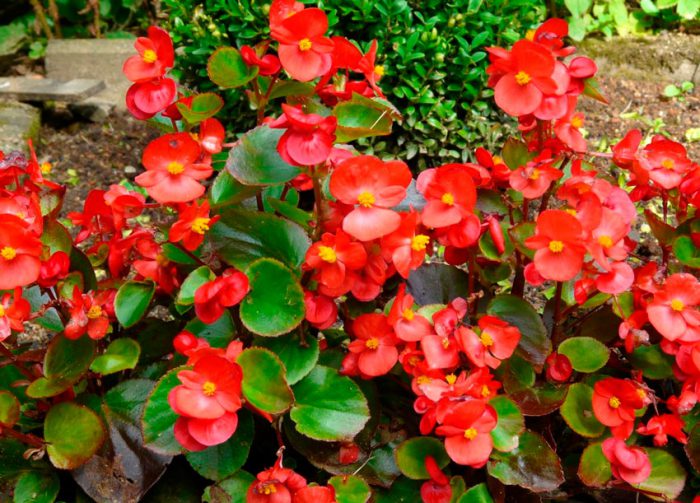
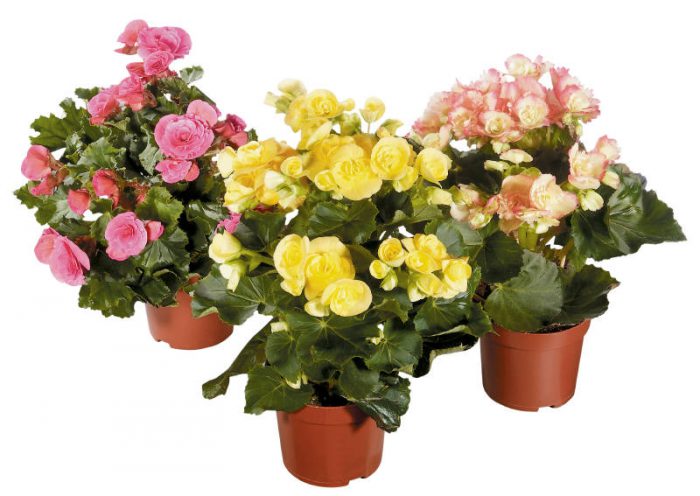
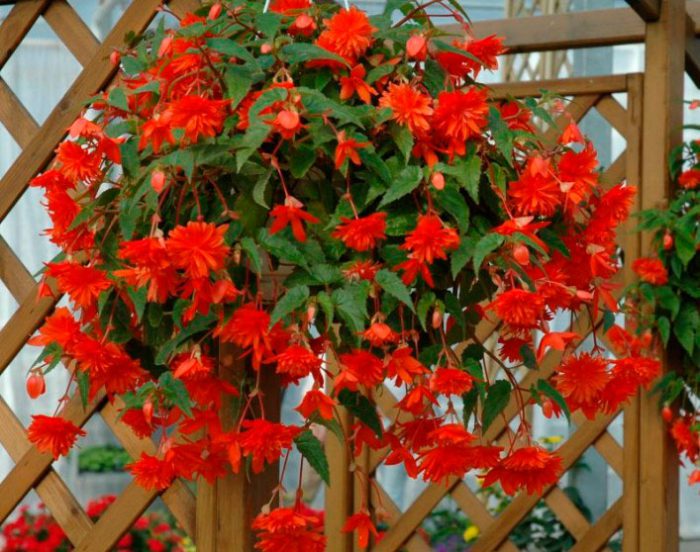

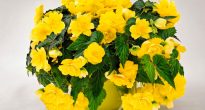
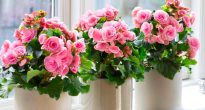
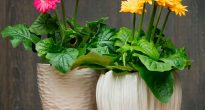
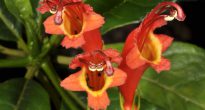
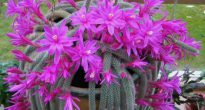
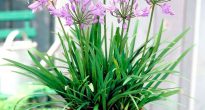

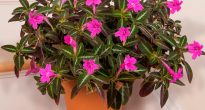
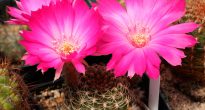

When a begonia has a flower and a bud withering, I ask for advice on what to do.
The barrel itself rotates what to do
Coral begonia stretched too far upward, from a fluffy bush turned into a fragile tree with long bare stems. How to rejuvenate it? can you just cut the top branches? Thanks in advance if you can help!
Feel free to cut, the side stems will go.
delighted with begonias and really liked your publication